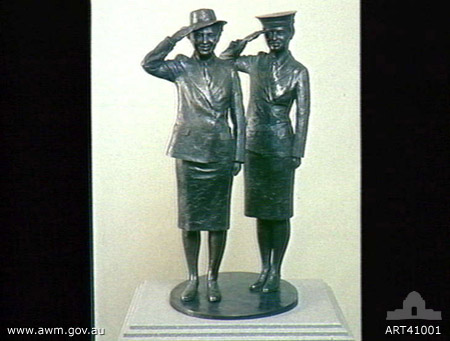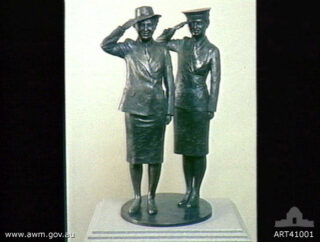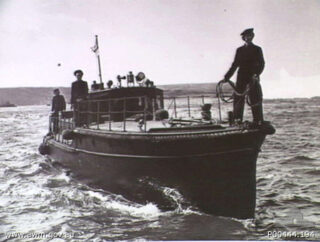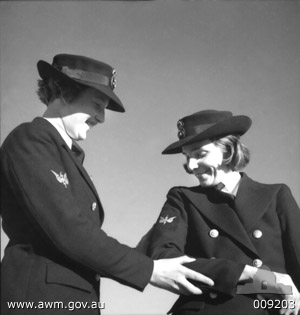- Entry type: Organisation
- Entry ID: AWE0387
Women’s Royal Australian Naval Service (WRANS)
(From 1941 – 1984)
- Occupation Armed services organisation
Summary
The Women’s Royal Australian Naval Service (WRANS) was established in April 1941 when the Royal Australian Navy enrolled 14 women at HMAS Harman, the wireless telegraphy station near Canberra. It was a non-combat branch of the Royal Australian Navy that, like many of its sister services created during the Second World War, alleviated manpower shortages resulting from men being assigned to combat roles.
WRANS performed a variety of duties, including working as telegraphists, coders and clerks; but also as drivers, education officers, mechanics, harbour messengers, cooks and sickberth attendants. They worked for intelligence organisations and as domestic staff at Government House, Yarralumla.
The Service was temporarily disbanded in 1948, but was re-formed in 1951 to help the RAN cope with manpower shortages. By 1959 the organisation was incorporated as a non-combatant (and thus non-seagoing) part of the permanent naval forces.
Women were permitted to serve aboard Australian naval ships in 1983, which meant that WRANS personnel were fully integrated into the Royal Australian Navy. This being the case, 1984 the WRANS was permanently disbanded.
Details
The Women’s Royal Australian Naval Service (WRANS) was initially established with 14 females trained by Florence McKenzie as wireless telegraphists. The Royal Australian Navy enrolled the first 14 girls in April 1941 at HMAS Harman Wireless Telegraphy station. Later on 1 October 1942 they were sworn into the Navy as enlisted personnel with enlisted status. This is regarded as the formal foundation date for the organisation.
The First Fourteen at HMAS Harman
- WR 1 Frances Provan
- WR 2 Joan Furley
- WR 3 Pat Ross
- WR 4 Denise Owen
- WR 5 Marion Stevens
- WR 6 June McLeod
- WR 7 Daphne Wright
- WR 8 Jess Prain
- WR 9 Joan Cade
- WR 10 Joan Hodges
- WR 11 Billie Thompson
- WR 12 Judy Alley
- WR 13 Shirley Drew
- WR 14 Elsie Colless – did not enlist in the Navy but took her discharge.
Four months later the number was increased to 1000. [1]
Patsy Adam-Smith, author of Australian Women at War, states that the service never exceeded 3000 women enlisted at one time. In the WRANS women worked as telegraphists; coders; writers (typists and clerks); transport drivers; car drivers; office orderlies; dental mechanics; cooks; sickberth attendants; stewardesses; press relations officers (which included escorting the press to sea on trials); boarding officers; almoners; dome teacher operators (visual aids used for instruction and entertainment); education officers; vocational guidance; sea transport officers; and air liaison officers (moving RAN officers and ratings to all parts of the globe). There were harbour messengers; an accountant officer; supply assistants; medical, clothing and general stores; a postmaster; a postal clerk (delivering mail to ships in port and on anchor); and watch keepers. There were WRANS working as Translation Interpreters in the Allied Translation Section of General MacArthur’s main ‘Order of Battle’. Some worked on the degaussing range (assessing the magnetic attraction of vessels as they crossed the degaussing range); they worked in ciphers; visual signalling; signals and communications; radio telegraphy plotting; and as messengers. Others were with the Radar Counter-measure, Allied Intelligence Bureau and Censorship Officers. They were at the Gunnery School, small arms range. One job was to handle all Safe Hand Mail for the port of Sydney, while another was to correct and issue charts to both merchant and naval ship’s masters. There was an Assistant to the Staff Officer (Operations) Brisbane and another to the Director of Victualling.
Many WRANS were engaged on technical duties of a secret nature, working long hours under exacting conditions. For many, this meant absolute silence about their work, even after demobilisation, while the end of the war meant that others were released from secrecy. While the most senior men were adamant that WRANS would not work as mechanics, they did indeed work in ordnance artificers’ workshops. Several women wore WRANS uniform merely for convenience or safety against the event of their being discovered and, as a civilian, being treated as a spy. [2]
The last wartime WRAN was discharged in 1948 when the WRANS were disbanded, but the service was reconstituted in 1951. By 1959 the WRANS were part of the Permanent Naval Forces, but Government policy of the day was that servicewomen not be employed in combat duties, and members of the WRANS were excluded from seagoing employment.
In 1985 women became fully integrated into the Royal Australian Navy and the WRANS were disbanded by an Act of Parliament. [3]
[1] Ships Belles pp. 67-70
[2] Australian Women at war. p. 215, pp 376-377
[3] http://www.gunplot.net/wrans/wrans1.htm accessed 2002-11-28
Archival resources
-
Australian War Memorial, Research Centre
- Archbishop Daniel Mannix, Catholic Chaplain General of the Australian Army with three unidentified representatives from the Australian Army Nursing Service (AANS), Women's …
- Members of the first WRANS Officer Training Corps.
- Senior WRANS from HMAS Harman Naval Wireless Station at the fourth birthday of the service
- Panorama group portrait of members of the Women's Royal Australian Naval Service (WRANS) at HMAS Rushcutter and two Navy officers.
- An informal group of members of the Women's Royal Australian Naval Service (WRANS) on the wharf at Garden Island.
- Huie, Shirley Fenton
- Heather Stella Starr (previously Blair), Leading Telegraphist, Women's Royal Australian Naval Service, interviewed by Dr Ruth Thompson for The Keith Murdoch Sound Archive of Australia in the War of 1939-45
- Australian servicewomen's memorial
- Margaret Curtis-Otter, Acting First Officer, Women's Royal Australian Naval Service, interviewed by Dr Ruth Thompson for The Keith Murdoch Sound Archive of Australia in the War of 1939-45
- National Library of Australia, Oral History and Folklore Collection
Digital resources
Published resources
-
Book
- Australian women at war, Adam-Smith, Patsy, 1984
- Ships belles : the story of the Women's Royal Australian Naval Service in war and peace 1941-1985, Fenton Huie, Shirley, 2000
- We also served, far north coast N.S.W. ex-servicewomen 1939-1945, Buckley, Martin J., c1995
- W.R.A.N.S. : the Women's Royal Australian Naval Service, Curtis-Otter, M, 1975
-
Resource Section
- Australian Women and World War ll: Kit, http://infocus.sl.nsw.gov.au/res/resdesc.cfm?res_code=1269
- The mobilisation of women into active services / the 'Yankee' invasion / How the war affected women, http://infocus.sl.nsw.gov.au/res/resdesc.cfm?res_code=1272
- Australian Servicewomen's Memorial, Southwell-Keely, Michael, 1999, http://www.skp.com.au/memorials/pages/00018.htm
- Book Section
- Resource
Related entries
-
Related Women
-
Hill, Dorothy (1907 - 1997)
-
McKenzie, Florence Violet (1892 - 1982)
-
Curtis-Otter, Margaret Catherine (1910 - 1992)
-
Jorgenson, June (1924 - 2019)
-
McDonald, Grace Thelma (1927 - 2013)
-
Darling, Margaret Florence (1923 - 2010)
-
Provan, Frances Betty (1911 - 1963)
-
Stevens, Marion (1920 - 2015)
-
Taylor, Marjorie Elsie (1920 - 2011)
-
Doyle, Jess Scott (1921 - 1988)
-
Munro, Dorothy Jean (1921 - 2011)
-
Buscombe, Nina Dorothea Kestell (1919 - 2003)
-
MacLeod, Barbara Denise (1929 - 2000)
-
Grieve, Norma Retta (1925 - 2006)
-
Boye, Ruby (Olive) (1891 - 1990)
-
Hill, Dorothy (1907 - 1997)
-
Related Organisations
-
Related Cultural Artefacts
-
Director/s
-
Member


